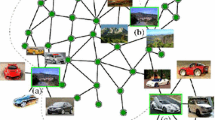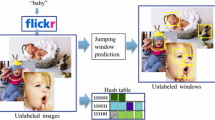Abstract
In this paper, we introduce a new form of the continuous relevance model (CRM), dubbed the SKL-CRM, that adaptively selects the best performing kernel per feature type for automatic image annotation. Previous image annotation models apply a standard selection of kernels to model the distribution of image features. Popular examples include a Gaussian kernel for modelling GIST features or a Laplacian kernel for global colour histograms. In this work, we demonstrate that this standard assignment of kernels to feature types is sub-optimal and a substantially higher image annotation accuracy can be attained by adapting the kernel-feature assignment. We formulate an efficient greedy algorithm to find the best kernel-feature alignment and show that it is able to rapidly find a sparse subset of features that maximises annotation \(F_{1}\) score. In a second contribution, we introduce two data-adaptive kernels for image annotation—the generalised Gaussian and multinomial kernels—which we demonstrate can better model the distribution of image features as compared to standard kernels. Evaluation is conducted on three standard image datasets across a selection of different feature representations. The proposed SKL-CRM model is found to attain performance that is competitive to a suite of state-of-the-art image annotation models.








Similar content being viewed by others
Notes
Users are known to find it particularly difficult to represent their image needs via abstract image features [23].
In preliminary experiments, we also found that z-score normalisation has a similar effect, but for simplicity we report the max–min normalisation results in this paper.
We use Minkowski kernel and generalised Gaussian interchangeably to refer to the same kernel in this work.
Features computed in a spatial arrangement are denoted with a V3H1 suffix in this paper.
References
von Ahn L, Dabbish L (2005) Esp: labeling images with a computer game. In: AAAI spring symposium: knowledge cfrom volunteer contributors, pp 91–98
Ames M, Naaman M (2007) Why we tag: motivations for annotation in mobile and online media. In: Proceedings of the SIGCHI conference on human factors in computing systems, CHI ’07ACM, New York, NY, USA, pp 971–980
Arandjelovic R, Zisserman A (2012) Three things everyone should know to improve object retrieval. In: CVPR. IEEE, New York, pp 2911–2918
Barnard K, Duygulu P, Forsyth D, de Freitas N, Blei DM, Jordan MI (2003) Matching words and pictures. J Mach Learn Res 3:1107–1135
Blei DM, Jordan MI (2003) Modeling annotated data. In: Proceedings of the 26th annual international ACM SIGIR conference on research and development in informaion retrieval, SIGIR ’03ACM, New York, NY, USA, pp 127–134
Carneiro G, Chan AB, Moreno PJ, Vasconcelos N (2007) Supervised learning of semantic classes for image annotation and retrieval. IEEE Trans Pattern Anal Mach Intell 29(3):394–410
Chapelle O, Haffner P, Vapnik VN (1999) Support vector machines for histogram-based image classification. Trans Neural Netw 10(5):1055–1064
Chen M, Zheng A, Weinberger KQ (2013) Fast image tagging. In: Dasgupta S, Mcallester D (eds) Proceedings of the 30th international conference on machine learning (ICML-13), vol 28, pp 1274–1282. JMLR workshop and conference proceedings
Cooper WS (1995) Some inconsistencies and misidentified modeling assumptions in probabilistic information retrieval. ACM Trans Inf Syst 13(1):100–111
Cusano C, Ciocca G, Schettini R (2003) Image annotation using SVM. In: Santini S, Schettini R (eds) Internet imaging V, society of photo-optical instrumentation engineers (SPIE) conference Series, vol 5304, pp 330–338
Duygulu P, Barnard K, de Freitas JFG, Forsyth DA (2002) Object recognition as machine translation: learning a lexicon for a fixed image vocabulary. In: Proceedings of the 7th European conference on computer vision-part IV, ECCV ’02. Springer, London, pp 97–112
Enser P, Sandom C, Lewis P (2005) Automatic annotation of images from the practitioner perspective. In: Image and video retrieval, pp 497–506
Feng SL, Manmatha R, Lavrenko V (2004) Multiple bernoulli relevance models for image and video annotation. In: Proceedings of the 2004 IEEE computer society conference on computer vision and pattern recognition, CVPR’04. IEEE Computer Society, Washington, DC, pp 1002–1009
Fu H, Zhang Q, Qiu G (2012) Random forest for image annotation. In: Proceedings of the 12th European conference on computer vision, , ECCV’12, vol Part VI. Springer, Berlin, pp 86–99
Grangier D, Bengio S (2008) A discriminative kernel-based approach to rank images from text queries. IEEE Trans Pattern Anal Mach Intell 30(8):1371–1384. doi:10.1109/TPAMI.2007.70791
Grubinger M (2007) Analysis and evaluation of visual information systems performance. PhD thesis, School of Computer Science and Mathematics, Faculty of Health, Engineering and Science, Victoria University, Melbourne, Australia
Guillaumin M, Mensink T, Verbeek J, Schmid C (2009) Tagprop: discriminative metric learning in nearest neighbor models for image auto-annotation. In: International conference on computer vision, pp 309–316
Hentschel C, Stober S, Nrnberger A, Detyniecki M (2007) Automatic image annotation using a visual dictionary based on reliable image segmentation. In: Adaptive multimedia retrieval. Lecture Notes in Computer Science, vol 4918. Springer, Berlin, pp 45–56
Howarth P, Rüger S (2005) Fractional distance measures for content-based image retrieval. In: Proceedings of the 27th European conference on advances in information retrieval research, ECIR’05. Springer, Berlin, pp 447–456
Huang J, Kumar SR, Zabih R (1998) An automatic hierarchical image classification scheme. In: Proceedings of the Sixth ACM international conference on multimedia, MULTIMEDIA ’98. ACM, New York, pp 219–228
Indyk P, Motwani R (1998) Approximate nearest neighbors: Towards removing the curse of dimensionality. In: Proceedings of the thirtieth annual ACM symposium on theory of computing, STOC ’98. ACM, New York, pp 604–613
Jeon J, Lavrenko V, Manmatha R (2003) Automatic image annotation and retrieval using cross-media relevance models. In: Proceedings of the 26th annual international ACM SIGIR conference on research and development in Information retrieval, SIGIR ’03. ACM, New York, pp 119–126
Jeon J, Manmatha R (2004) Using maximum entropy for automatic image annotation. In: CIVR. Lecture Notes in Computer Science, vol 3115. Springer, Berlin, pp. 24–32
Joachims T (2002) Optimizing search engines using clickthrough data. In: Proceedings of the eighth ACM SIGKDD international conference on knowledge discovery and data mining, KDD ’02. ACM, New York, pp 133–142
Lavrenko V, Feng S, Manmatha R (2004) Statistical models for automatic video annotation and retrieval. ICASSP 3:1044–1047
Lavrenko V, Manmatha R, Jeon J (2003) A model for learning the semantics of pictures. NIPS
Lazebnik S, Schmid C, Ponce J (2006) Beyond bags of features: Spatial pyramid matching for recognizing natural scene categories. In: Proceedings of the 2006 IEEE computer society conference on computer vision and pattern recognition, CVPR ’06, vol 2. IEEE Computer Society, Washington, DC, pp 2169–2178
Liu J, Li M, Liu Q, Lu H, Ma S (2009) Image annotation via graph learning. Pattern Recognit 42(2):218–228
Lowe DG (2004) Distinctive image features from scale-invariant keypoints. Int J Comput Vis 60(2):91–110
Makadia A, Pavlovic V, Kumar S (2008) A new baseline for image annotation. In: Proceedings of the 10th European conference on computer vision: part III, ECCV ’08. Springer, Berlin, pp 316–329
Markkula M, Sormunen E (2000) End-user searching challenges indexing practices in the digital newspaper photo archive. Inf Retr 1(4):259–285
Metzler D, Manmatha R (2004) An inference network approach to image retrieval. In: Proceedings of the international conference on image and video retrieval. Springer, Berlin, pp 42–50.
Mittelman R, Lee H, Kuipers B, Savarese S (2013) Weakly supervised learning of mid-level features with beta-bernoulli process restricted boltzmann machines. In: Proceedings of the 2013 IEEE conference on computer vision and pattern recognition, CVPR ’13. IEEE Computer Society, Washington, DC, pp 476–483
Moran S, Lavrenko V (2011) Optimal tag sets for automatic image annotation. In: Proceedings of the British machine vision conference. BMVA Press, London, pp 1.1–1.11
Moran S, Lavrenko V (2014) Sparse kernel learning for image annotation. In: Proceedings of international conference on multimedia retrieval, ICMR ’14. ACM, New York, pp 113:113–113:120
Moran S, Lavrenko V, Osborne M (2013) Variable bit quantisation for lsh. In: Proceedings of the 51st annual meeting of the association for computational linguistics (vol 2: short papers). Association for Computational Linguistics, Sofia, pp. 753–758
Mori Y, Takahashi H, Oka R (1999) Image-to-word transformation based on dividing and vector quantizing images with words. In: MISRM’99 first international workshop on multimedia intelligent storage and retrieval management
Nakayama H (2011) Linear distance metric learning for large-scale generic image recognition. PhD thesis, The University of Tokyo, Japan
Oliva A, Schyns P (2000) Diagnostic colors mediate scene recognition. Cogn Psychol 41(2):176–210
Oliva A, Torralba A (2001) Modeling the shape of the scene: a holistic representation of the spatial envelope. Int J Comput Vis 42(3):145–175
Richtárik P, Takác M (2013) Distributed coordinate descent method for learning with big data. In: CoRR’13
Shi J, Malik J (2000) Normalized cuts and image segmentation. IEEE Trans Pattern Anal Mach Intell 22(8):888–905
Smucker MD, Allan J, Carterette B (2007) A comparison of statistical significance tests for information retrieval evaluation. In: Proceedings of the sixteenth ACM conference on information and knowledge management, CIKM ’07. ACM, New York, pp 623–632
Ulz MH, Moran SJ (2013) Optimal kernel shape and bandwidth for atomistic support of continuum stress. Model Simul Mater Sci Eng 21(8):085, 017
Verma Y, Jawahar CV (2012) Image annotation using metric learning in semantic neighbourhoods. In: Proceedings of the 12th European conference on computer vision, ECCV’12, vol Part III. Springer, Berlin, pp 836–849
Wang B, Li ZW, Yu N, Li M (2007) Image annotation in a progressive way. In: Proceedings of ICME, pp 811–814
van de Weijer J, Schmid C (2006) Coloring local feature extraction. In: Proceedings of the 9th European conference on computer vision, ECCV’06, vol Part II. Springer, Berlin, pp 334–348
Weinberger KQ, Saul LK (2009) Distance metric learning for large margin nearest neighbor classification. J Mach Learn Res 10:207–244
Weston J, Bengio S, Usunier N (2010) Large scale image annotation: learning to rank with joint word-image embeddings. Mach Learn 81(1):21–35
Xiang Y, Zhou X, Unviersity F, seng Chua T, wah Ngo C (2009) A revisit of generative model for automatic image annotation using markov random fields. In: Proceedings of IEEE computer vision and pattern recognition, pp 1153–1160
Yakhnenko O, Honavar V (2008) Annotating images and image objects using a hierarchical dirichlet process model. In: Proceedings of the 9th international workshop on multimedia data mining: held in conjunction with the ACM SIGKDD 2008, MDM ’08. ACM, New York, pp 1–7
Yashaswi Verma CJ (2013)Exploring svm for image annotation in presence of confusing labels. In: Proceedings of the British machine vision conference. BMVA Press, London
Yavlinsky A, Schofield E, Rüger S (2005) Automated image annotation using global features and robust nonparametric density estimation. In: Proceedings of the 4th international conference on image and video retrieval, CIVR’05. Springer, Berlin, pp 507–517
Zhang S, Huang J, Huang Y, Yu Y, Li H, Metaxas DN (2010) Automatic image annotation using group sparsity. In: CVPR. IEEE, New York, pp 3312–3319
Zhu S, Liu Y (2008) Image annotation refinement using semantic similarity correlation. In: ICPR’08
Acknowledgments
We thank the anonymous reviewer for their helpful comments.
Author information
Authors and Affiliations
Corresponding author
Rights and permissions
About this article
Cite this article
Moran, S., Lavrenko, V. A sparse kernel relevance model for automatic image annotation. Int J Multimed Info Retr 3, 209–229 (2014). https://doi.org/10.1007/s13735-014-0063-y
Received:
Accepted:
Published:
Issue Date:
DOI: https://doi.org/10.1007/s13735-014-0063-y




